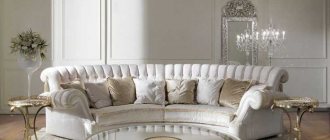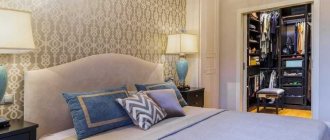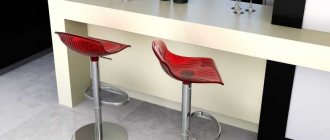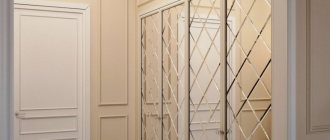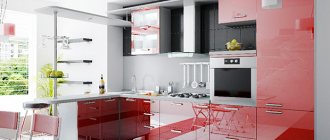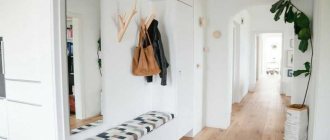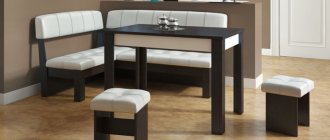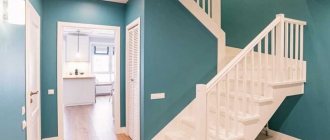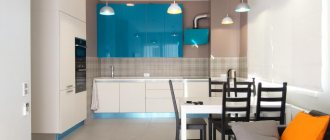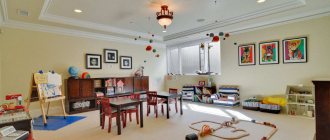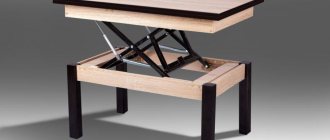Style Features
The coziness and comfort achieved by this design harmoniously combines the simplicity of rural design and the light sophistication of fashionable Parisian salons.
The style itself owes its appearance to the court ladies and gentlemen of France, who periodically went to their own villages to take a break from the intrigues of the throne and relax surrounded by their own subjects.
Since those long ago, interior design in the Provence style has not changed much. It is still characterized by:
- soft pastel colors;
- using natural materials;
- vintage furniture and decor;
- abundance of light;
- high ceilings and spaciousness.
The style should create the impression of a cozy space, not burdened with complex solutions. It will be comfortable for people of any age.
Color spectrum
In Provence, the pastel palette in all its manifestations rules. The main advantage of bleached and faded shades is their excellent compatibility with each other. Catchy contrasts are almost never used in such interiors.
Lavender color
Lavender is one of the main symbols of Provence, so it’s almost impossible to do without it in the interior. And if you want to dilute the colors, pay attention to violet, lilac, and wisteria.
Light green color
Choose warm milky shades of light green, not too neon and not too lemony. Complex colors are also good: mint, olive, khaki - they all fit harmoniously into the aesthetics of Provence.
Blue color
In Provence style interiors, heavenly and floral shades of blue are good. Forget-me-not, cornflower blue and azure tones look interesting. And if you need something more complex - turquoise, sea wave or cyan.
Pink color
Provence is not characterized by doll pink, but muted ash, dusty, pearl and smoky colors look very organic. Salmon is also good - a real trend that will give an antique interior a light modern touch.
Bright shades
For bright accents, use complex rich shades of pink, magenta, orange, mustard, and grassy green. The main thing is to choose natural colors, not their flashy synthetic variations.
Dark shades
For dark accents, use deep muted tones: eggplant, grape, chocolate, cobalt, sapphire, malachite. Radical black is practically never found in elegant French interiors.
Neoclassical style in the interior: 95 photo ideas
Walls
Wall surfaces are designed:
- paint;
- simple plaster;
- wooden panels.
At the same time, small uneven finishes will give the walls an additional charm of antiquity and manual labor. A brick wall made of white or red painted brick looks stylish. Most often, this option is used to decorate one wall.
Wallpaper in the Provence style in the interior is characterized by a light background on which floral patterns are freely arranged. In more formal rooms, a thin strip or checkered pattern is used.
Color and decor options
Provence style is not characterized by bright or very dark colors. To decorate rooms, it is optimal to use:
- white;
- blue;
- turquoise;
- lavender;
- beige;
- sand;
- cream;
- lactic;
- olive.
What should be furniture in the style of minimalism, distinctive features
When using wooden elements, it is advisable to preserve their natural color. If this is not provided for by the selected design, any surface can be easily painted. Forged products can also be presented in any color scheme. Textiles are characterized by all pastel colors with small, unobtrusive floral patterns, stripes, and checkered designs.
The decoration of furniture and the room as a whole plays an important role. All kinds of figurines, vases, lamps in the Provencal style will not just complement the interior, but will make it more comfortable and elegant. Of all the possible types of finishing of furniture facades, the leading positions are occupied by patination and carving.
Furniture in Provence style
Furniture in the Provence style is a unique combination of simplicity and elegance. To create an authentic design, they use vintage furniture that can be found in the attics of village houses. Small abrasions and restored chips will add additional antique charm to the furniture.
In order not to spend money on buying expensive antiques in special showrooms, you can purchase the most ordinary sets and artificially age them with special varnishes, cover them with paint and decorate them using decoupage napkins.
Furniture items are distinguished by simple shapes and finished lines. They can be quite crude and give the impression of items made independently, somewhere in a home workshop. Carved legs and facades, floral decoration, bronze or porcelain fittings give such items the necessary grace.
Light-colored wood will create a feeling of spaciousness and light. Sometimes it is additionally coated with a thin layer of light paint, through which the original material will be visible.
Rattan wicker items will be a non-standard furniture option. Such cozy chairs are usually complemented by a large number of pillows or knitted blankets.
For Provence there are no restrictions on the amount of furniture used. In large rooms, in addition to the standard set, you can place small chests of drawers, sideboards, and buffets.
Ottomans, couches, chairs, and armchairs placed throughout the house invite apartment residents and guests to sit down and enjoy the comfort of the interior.
Shapes and design
If you compare Provence style furniture from different manufacturers, the similarity of shapes and design will become obvious. Significant differences will only be in the quality of materials and the final cost of products. Otherwise, everything is traditional - the most common categories of furniture are:
- Cabinets. The variety of types is represented by large, small, cabinet, built-in, hinged, sliding models. Artistic painting, modeling, as well as carved and forged elements look great on furniture.
- Tables. There are round, oval, rectangular. The latter are considered the most practical. The base has curved wooden or forged legs, and the tabletop is usually made of natural wood.
- Chairs and stools. They always combine simplicity and elegance. They are characterized by smooth lines, carved elements, and twisted patterns. The back can be high, low or absent altogether. A Provencal stool is often complemented by refined curves or has strict lines, depending on the chosen design.
- Sofas. Most models are equipped with high backs that smoothly merge into armrests. However, corner and standard options are no less in demand. Their sizes do not have strict restrictions.
- Armchairs. Along with the classic options, rocking chairs and models that transform into beds are in high demand. The first ones are ideal for a living room or bedroom, where other Provence furniture is selected in the same style. French charm should be emphasized by capes with lace, pillows of a characteristic color, and other decorative elements.
Upholstered furniture is divided into traditional, wicker and even hanging. The last option is the least common in the Provencal style, since it is difficult to make it an integral part of the interior. It is important to take into account all the elements of a particular room and select harmonious products for its further arrangement.
An aging effect should be applied to any type of furniture in the Provence style.
Textiles in the interior
Home textiles will help create a feeling of home warmth and ancient comfort.
Light curtains made from natural fabrics complement large windows, practically not blocking the sun's rays and fresh air. They can be gathered into pretty folds, decorated with lambrequins and bows, light tiebacks and ribbons. Multi-layer curtains mounted on wooden or iron cornices with forged finials will look great.
Soft plain fabrics or materials with floral patterns, checks, stripes, repeating the wallpaper pattern or complementing the laconicism of the walls are welcome.
Upholstery of upholstered furniture is matched to curtains or walls. Sofas, armchairs, and couches are decorated with decorative pillows; tablecloths and napkins with embroidery or lace are laid out on the tables. The floors are decorated with soft carpets in light colors.
Furniture aging techniques
One way to transform modern furniture into provincial-style furnishings is to age it. However, this effect can be achieved using various methods. The most effective and frequently used are:
| Aging methods | Peculiarities |
| Mechanical | Scratches, chips, cracks are caused artificially |
| Thermal | The effect is achieved by exposing the treated surface to open fire. |
| Chemical | Stain, ammonia, craquelure varnish, paint are used |
The chemical aging method is most often used, using various processing techniques and materials.
- Paint treatment
We treat the surface with paint in several layers
This type of work does not require major financial investments - water-based paint of the appropriate color is usually used. Before applying it, the area is treated with acrylic wood primer. After complete drying, light-colored paint is applied or a ready-made artificial patina is used.
Advice. The final coating is best done using matte varnish - it is more appropriate for this style.
- Using paraffin and paint
We rub paraffin on those parts of the product that should be beautifully shabby: edges, corners
A simple option for processing furniture, for which the old paintwork is removed from the area being treated with sandpaper. Then the surface is rubbed with paraffin, and then paint is sprayed from a can.
We spray paint from an aerosol can - it is more convenient when painting cracks and other hard-to-reach places
At the same time, there is absolutely no need to achieve an even layer of coating: individual unpainted areas will correspond to Provence.
To create the effect of wear and tear and layers of paint showing through from under each other, you can apply the paint with a sponge
After drying, the painted wood is treated with a clean, hard sponge, which removes excess material. It is important not to overdo it here, so as not to remove most of the applied coating.
We remove excess layers of paint with sandpaper
To enhance the aging effect, craquelure varnish is used.
Craquelures (decorative cracks) are the most difficult and unpredictable way to age furniture
In addition, design techniques are used to give the home the appropriate style features:
- the use of fabrics that reflect the style features;
- production of additional figured design elements;
- selection of traditional color solutions for a given style;
- finishing furniture with paint with a gilding effect;
- decoration with stylized accessories.
Patination gives the interior an atmosphere of noble antiquity and luxury
Decor
Provence, like all other rustic styles, loves a lot of decorative elements.
The following will look great in this interior:
- paintings with pastoral scenes or natural beauties in gilded frames;
- antique mirrors in wrought iron frames;
- caskets;
- vases;
- fresh or dried flowers;
- antique dolls;
- china;
- figurines;
- candlesticks;
- wicker baskets;
- handicraft items.
Homemade items of any kind are welcome. The most difficult thing in decorating Provence is to be able to stop without turning the room into a branch of the museum.
Lighting in Provence style
Provence requires a lot of light. Natural flow will come from large windows decorated with white frames. Artificial lighting will provide several levels of forced illumination.
The main element of lighting continues to be the ceiling chandelier. It is distinguished by its massiveness, which is imparted by a forged frame, and the lightness provided by glass and crystal pendants, fabric and wicker lampshades.
Wall sconces are matched to the tone of the main lamp. Imitations of candles or gas lamps will look great.
An excellent option for decorating a room would be cozy floor lamps, reminiscent of the romance of bygone times. They are placed everywhere, from the living room to the hallway.
All of the listed design techniques are suitable for use in all rooms. But small tricks will make each room even more cozy and “French”.
Kitchen in Provence style
The Provence style in the kitchen interior will create a joyful mood that will help you prepare delicious food and eat it with pleasure. The kitchen is most often combined with the dining room, and modern household appliances are hidden behind cabinet fronts or items are selected in a retro style.
Small “cafe” curtains will transport visitors to a village hut, where the decor will be painted plates, jars with spices, pickles and jams, ancient Turks and hand mills.
Living room in Provence style
The Provence style in the living room interior will create a soft corner and fireplace, shelves and chests of drawers. A fluffy carpet or burlap rug will look stylish on the floor. Flowers in vases or living plants will decorate the guest room.
General features of the Provence style
For all its diversity, Provence has many characteristic features that immediately emerge in the imagination even of people far from the world of design. These are pastel colors, handmade, bleached wood, carved furniture and an abundance of textiles.
The main shades are muted, diluted, faded. These are milky yellow, mint, cream, pale brown, beige, baby blue, pastel pink, lilac and lavender.
The interiors actively use aged furniture with simple and sometimes even naive decor. For example, with carved flowers, leaves, vines.
Small elements flourish in Provence: embroidered pillows, openwork napkins, small floral ornaments, candlesticks, living flowerpots.
Forged furniture, wooden ceiling beams, homespun carpets, linen sofa covers, and real fireplaces are actively used. All this emphasizes the rustic origins of the style.
Bedroom in Provence style
For the bedroom it is better to reduce the amount of furniture. A wide bed (with a base and headboard made of wood or metal) and a small chest of drawers will suffice here. A dressing table is placed for the beautiful inhabitant of the bedroom.
The textiles are decorated with ruffles, flounces, puffs, and lace.
Interior equipment
The interior of a room directly depends on its purpose. The equipment of different rooms may vary significantly. However, at least the living room and the bathroom should be a clear reflection of the sunny and light Provence.
Living room
When decorating a living room, it is better to give preference to the simplest possible designs without elaborate, complex decorative elements. Gloss, glass, plastic, and chrome parts are not allowed here. Suitable furniture items:
- a massive sideboard with signs of wear;
- aged round tables;
- cabinets without doors;
- chests of drawers with peeling finishes;
- tables, chairs with figured carvings;
- wicker chairs, sofas.
On the upholstery of upholstered furniture, curtains or tablecloths, patterns in the form of plant patterns and cages are allowed. You should not place products along the walls; they should be correctly grouped. The ideal solution for small apartments would be modular furniture.
Bedrooms
According to the Provencal style, a wooden or metal bed with a wrought-iron headboard is suitable for the bedroom. A patinated cabinet should be complemented with a large mirror. A light chest of drawers, an easy chair or carved chairs, and bedside tables will refresh the interior.
A special chest installed under the window. The main thing is that the selected furniture does not seem new and modern. When creating an interior, you should also pay attention to the choice of curtains; they should be made of light, airy materials.
Children's
White and very light products of simple geometric shapes with rounded edges are ideal for a children's room. Moldings, carvings, and paintings would be appropriate on the facades. Required furniture items:
- bed;
- wardrobe;
- table and chair;
- rack or cabinet for books, toys.
If the room area is small, the furniture set should be minimal.
For a girl, a dressing table will be an indispensable piece of furniture. A product with long, curved legs will look especially harmonious.
Kitchens
The dining table is a key element of the kitchen. It should be strict and massive in a large, spacious room. Owners of a small apartment should pay attention to transforming models. Chairs are made of wood or metal with forged elements, always with soft seats.
Characteristic features of furniture in English, overview of varieties
The set should be matte. The furniture decor consists of stained glass and glass inserts with plant motifs. You should choose a sink among the options made of ceramics, artificial, and natural stone. The design will be effectively complemented by an aged sideboard with beautiful dishes, as well as built-in and wall shelves without doors.
Hallway
A wardrobe for outerwear, a shoe rack, a chest of drawers, wicker baskets, and a hanger perform not only an aesthetic, but also a practical function in the hallway. A mandatory element is a mirror, which will not only expand the space, but also add some mystery to it. Moreover, it should be in a metal or wooden patinated frame. If you have space in the hallway, you can place a soft pouf there. Don’t forget about small details made in Provence style - hooks, lamps, key holder, door handles.
Provence style for a children's room
The style will be a wonderful decoration for a child's room. It is perfect for young princesses and romantically minded ladies.
To decorate the room of a boy or children of different sexes, choose a blue, green or soft brown color scheme, a pattern in the form of stripes.
Hallway in Provence style
The entrance area in Provence style will welcome guests with soft couches or ottomans, a large mirror, and floor vases. Photos of Provence style in the interior will help you better understand this amazing design option and find the most suitable details for yourself.
Provence style in the interior of a country house
The choice in favor of the Provence style is most often made by calm, balanced people who strive for harmony in everything. Moreover, such a simple, discreet interior can often be found in rich mansions, the owners of which could afford a luxurious renovation in a classic style, but preferred something more homely and cozy.
We have already talked a lot about the interior of a house in the Provence style, but in this case the exterior is no less important. In order for the appearance of the building to correspond to the spirit of Provence, its facade must be lined with wood, which is then painted or simply a protective coating is used. A mandatory element is a terrace or veranda decorated with flowers in pots.
Also, a “Provencal” house can be made of brick or stone. In this case, natural stone or, for example, tiles with imitation pebbles are used to cover the facade. Part of the wall can simply be covered with plaster and painted.
If the house is two-story, the owners can afford to make a balcony, which, in addition to its main functions, will become an excellent decoration of the exterior.
A very important issue is street lighting on the approach to the house and directly near the entrance to it. It is better to use forged metal lanterns or carved wooden lamps as lighting fixtures. If the house is old, some elements of the facade (window frames, columns, etc.) should not be restored.
In order for the atmosphere of Provence to be fully felt, it is necessary to decorate not only the house itself, but also the surrounding area. To transform the area, a small cozy gazebo with wicker furniture, the walls of which are entwined with grapevines, is enough. You can also plant lilacs, roses, wisteria or other flowers as decoration. A neat wooden fence will complete the picture.
